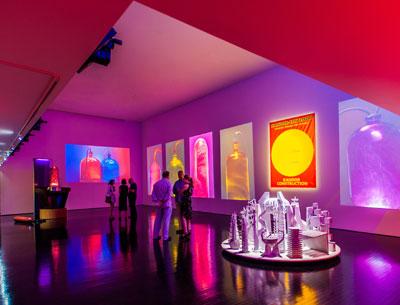Opinion - Mike Kelley: Fetish and Fixation

The tribute exhibition “Mike Kelley: 1954-2012,” organized by Harald Falckenberg at the Watermill Center, is not a retrospective, but through its works and catalog it does contribute a reasonably full measure of a man who, Mr. Falckenberg noted, may have been only .0002 percent finished with his work at the time of his suicide in January.
That amount was taken from a banner in his project “Kandor-Con 2000,” a millennial work in progress that became an all-encompassing oeuvre involving model-making, bell jars, video projections, an unfunded symposium, and other works of a similar theme alluding to the recreation of the city of Superman’s birth. With a number of related pieces and continuing contributions of models by architecture students that became incorporated into the ever-increasing output, it would seem that Kandor as a theme was a never-ending font of new creative energy for him and others.
Except, its progenitor chose instead to end it all, stating in November in an interview with Artillery magazine that he was going to stop making art, and that he was overworked and exhausted. Perhaps for someone with a boundless imagination and creative drive, to stop making art, as arduous and dispiriting as it was for him at times, was to stop all essential functions, such as breathing.
Kelley, who became synonymous with Cal Arts and the Los Angeles art scene as it began its rise in the late 1980s and 1990s, was not a product of Southern California, but of a repressive Catholic household in Detroit. That is why, despite calling Southern California home for decades, he always stood apart from it, and his work was equally at home on view in New York City and Europe.
As complicated as his residency was for him — he didn’t much like L.A. — he was an even more complex individual, pointing out as he did that he was too young to be a hippie and too old to be a punk, and was carving out some kind of hybrid approach to the two opposite sides of rebellion. He took a holistic approach to his embrace of punk, making music, or noise as he called it, with band mates over the years that included a fellow classmate at the University of Michigan, Jim Shaw, and later Tony Oursler in a band called the Poetics, of which a sampling from 1977 to 1983 plays in one of the galleries. Noise it is, but of an artful variety.
Kelley had an ongoing relationship with psychology, Freudian and otherwise, that infused his work with Surrealist concerns while he straddled and synthesized other significant artistic movements of the 20th century. In his “Half a Man” series, he touched on minimalism, Abstract Expressionism, kitsch, and appropriation, to name a few, mostly with well-worn handmade plush toys and afghans rescued from the bins of the Salvation Army. While these works evinced abjectness and a compromised ideal of masculinity, “Kandor” fixates on unattainable perfection to the point of fetish.
What is fascinating about this particular late work, especially in contrast with the video works also on view from as early as 1983 to 2011, is the amount of beauty in it. Kelley was a master of the decrepit, the forlorn, the scatological, the cruelly cast off. Works that didn’t have an actual odor still carried an implied scent of overripe human funk, of popped oozing zits, skidmarks on porcelain, and other mortal stains.
The video work tackles those concerns. “Banana Man” runs the gamut of banana-inspired double entendres and other things that resemble bananas but are less pleasant to look at. “Heidi” uses rubberized stand-ins for figures in a way that draws back the curtain on film illusionism. The cruel and brutal treatment Heidi confronts, in the words of Paul McCarthy, Kelley’s collaborator on the piece, subverts “the purity myth in America and Europe and the media view of family life, horror movies, and ornamentation.”
Despite their low production values and surreal and cartoonish stylings, the videos do accrue to each other in this setting. Even when familiar with their content, their disturbing imagery, while absorbing and fascinating to watch on one level, can make a viewer queasy and unsteady afterward, with a sense of vertigo akin to having just witnessed a bullfight. As instructive as the videos are when seen together, there is some sensory overload in watching them all at a sitting. Rather than taking a sampling of them, it may be better to choose one or two and leave the rest for another day in order to give them their full due.
This may be possible soon. A retrospective exhibition tour was in the planning stages before Kelley’s death and will now become memorial shows in the coming months, beginning in Amsterdam at the end of the year, with a stop in New York City at the Museum of Modern Art’s P.S. 1 in 2013. Until that time, it would be worthwhile to have a look at the Watermill installation to see the artist in one of his last creative efforts and some of his earlier ones.
The exhibition is on view through Sept. 16 and can be seen by appointment Tuesday through Friday from 4 to 6 p.m., and on weekends from 11 a.m. to 1 p.m. and 3 to 5 p.m.
